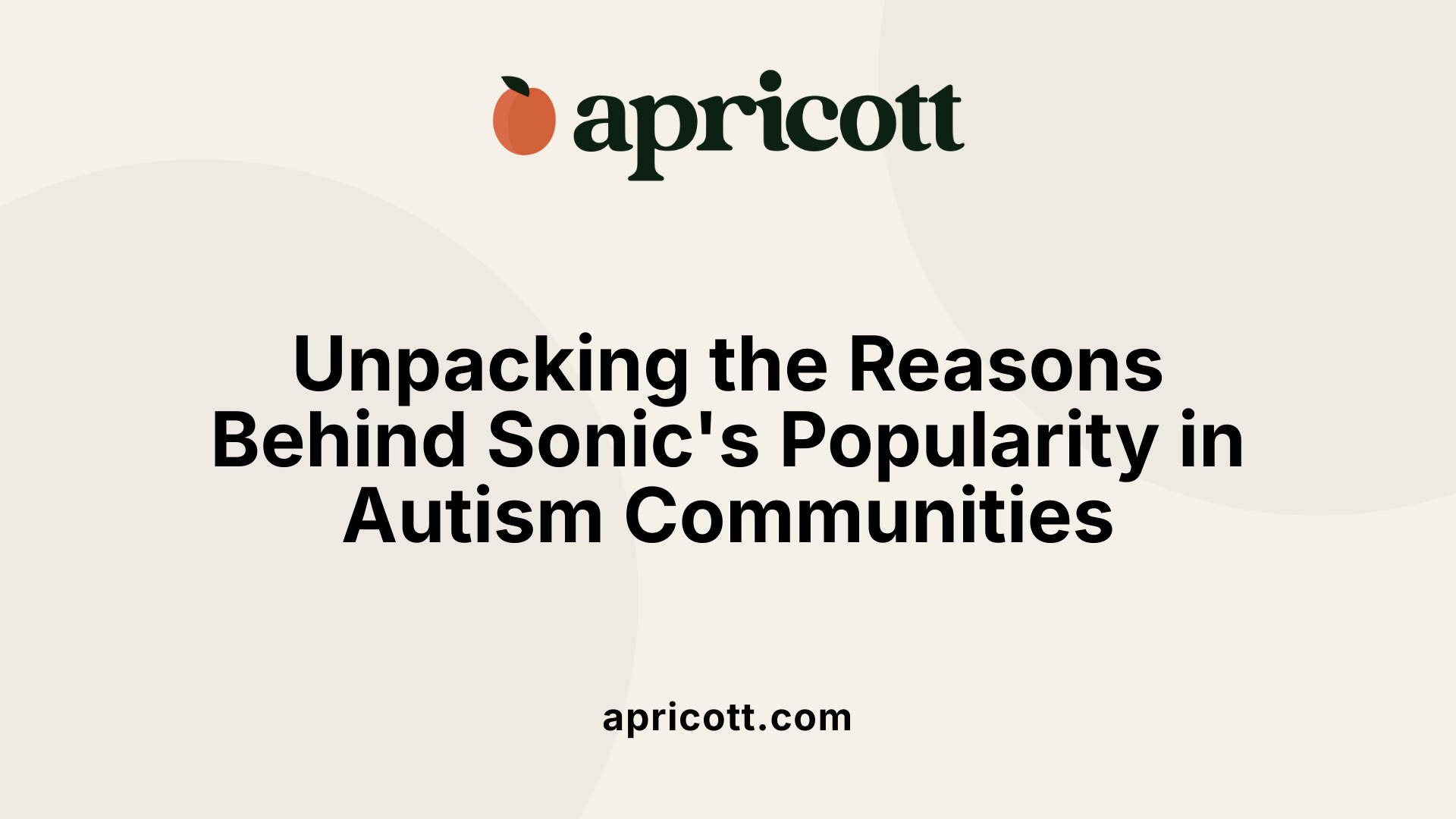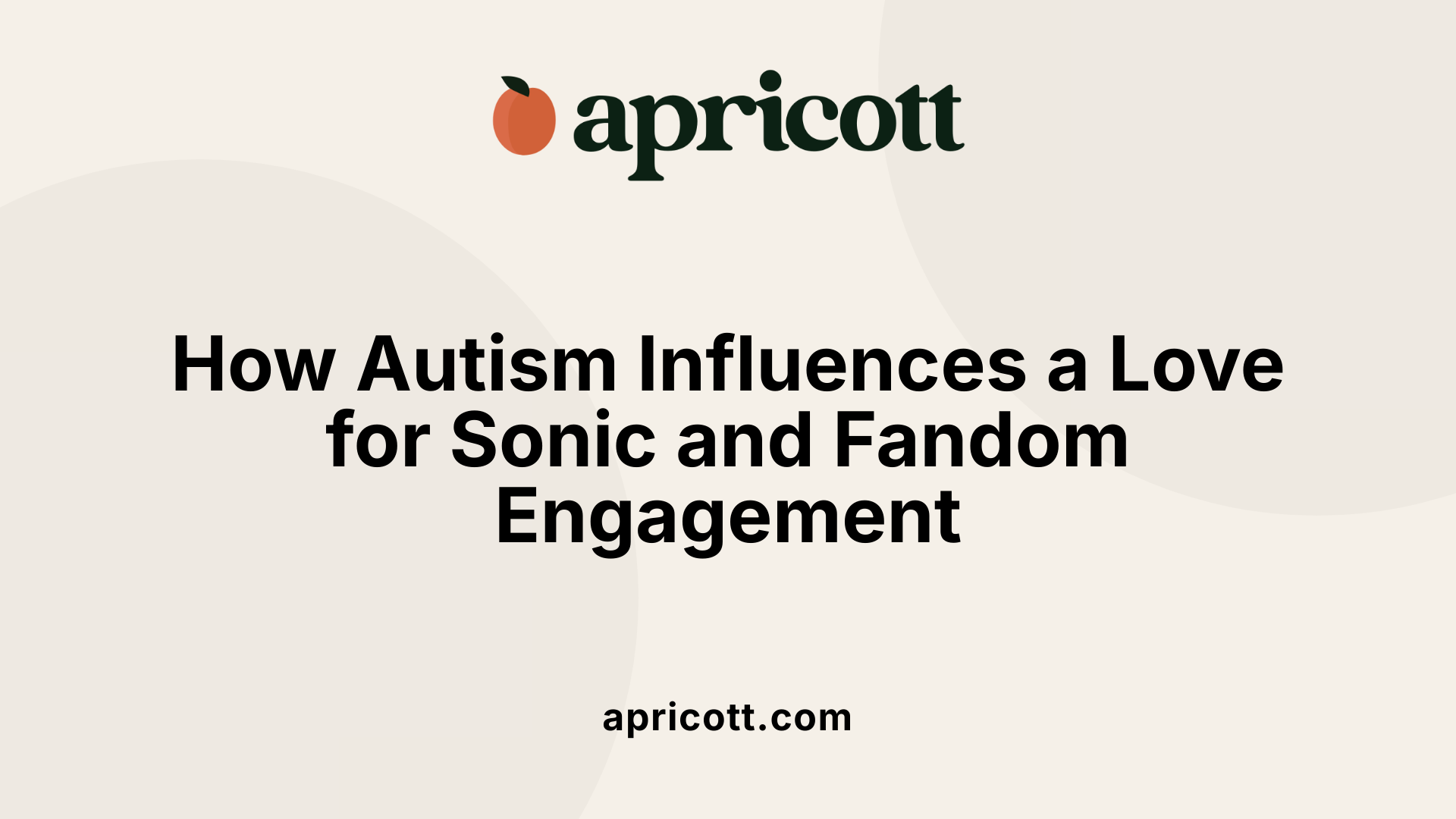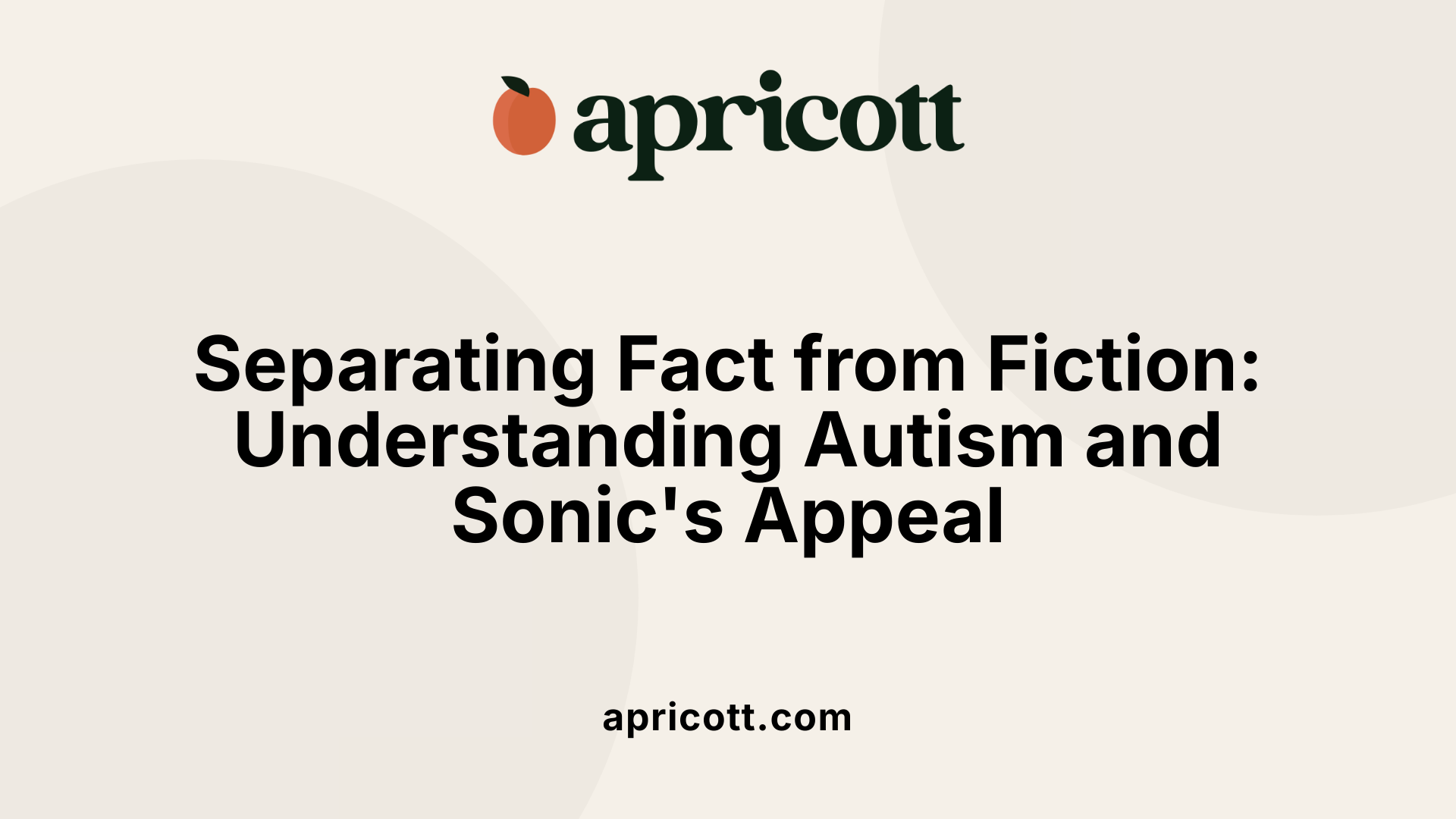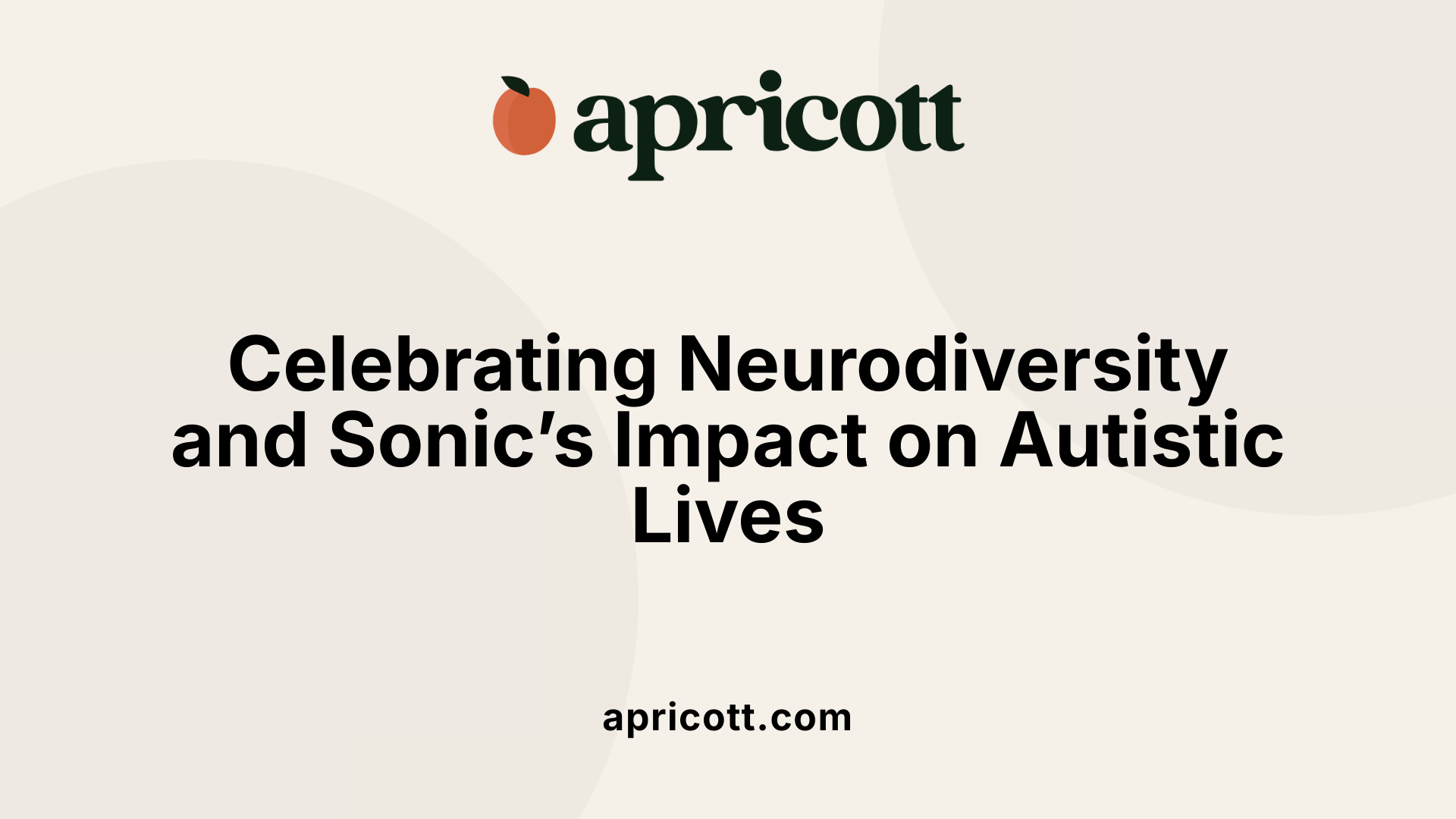Exploring the Fascination: Why Sonic Resonates with Autistic Individuals
Sonic the Hedgehog has captivated audiences for decades, not only as a video game icon but also as a symbol within diverse communities, including those of autistic individuals. This article examines the psychological, cultural, and personal factors that contribute to Sonic's special appeal among autistic fans and highlights stories that illustrate this unique bond.
The Psychological and Social Foundations of Sonic's Appeal to Autistic Fans
Why are Sonic games and fandoms appealing to autistic individuals?
Autistic individuals, especially those with high-functioning autism spectrum disorder, often develop very focused, intense interests. These interests can include characters, specific kinds of vehicles, or sensory-stimulating topics like video games. Sonic the Hedgehog, with its bright colors, fast-paced gameplay, and clear goals, fits well into this pattern.
The structure and predictability of Sonic games are comforting for many autistic players. The rule-based gameplay with consistent patterns offers a sense of control and stability. This predictability helps manage sensory overloads and social anxieties by providing a safe environment where the rules are clear and unchanging.
How do interests in Sonic foster empowerment and self-regulation?
Engaging with Sonic fandoms allows autistic individuals to feel a sense of mastery and competence. Completing levels, customizing characters, or discussing game strategies serve as activities that reinforce confidence and provide emotional regulation.
Many autistic fans find a way to express themselves through their Sonic interests. This expression can promote self-acceptance and help develop their identity around their passions. Furthermore, the familiarity and focus on these interests can serve as a calming anchor during stressful times.
How do sharing a Sonic interest build community connections?
Participating in Sonic fandoms offers opportunities for social interaction in a less intimidating manner. Shared passions often foster bonds among fans who might struggle with traditional social settings. Online forums, fan art, and collaborative projects become safe spaces for connection.
For many, these communities expand beyond mere fandom—they become vital social networks. Sharing enthusiasm over Sonic can bridge differences and create a sense of belonging and understanding among autistic individuals.
What are the broader implications of this fascination?
Research suggests that interests like Sonic are more than just hobbies—they are coping mechanisms and identity markers. They help autistic individuals navigate a complex world by providing predictability, a sense of competence, and social connection.
Understanding why Sonic appeals to autistic fans can inform approaches to fostering inclusivity in gaming and fandom spaces. Recognizing the importance of structured, predictable, and community-oriented interests can help create more accessible environments for neurodiverse individuals.
| Aspect | Details | Examples |
|---|---|---|
| Interest development | Deep, focused interests that provide structure and predictability | Sonic game levels, character design |
| Role in self-regulation | Offers emotional stability and a sense of mastery | Completing game levels, fan art |
| Social engagement | Facilitates community and shared passion | Online forums, fandom meetups |
| Impact on identity | Self-expression and acceptance through passionate involvement | Customizing characters, fan storytelling |
Understanding the connection between autistic interests and fandoms can help in designing more inclusive gaming environments. It also highlights the importance of shared passions for emotional health and community building among neurodiverse populations.
Cultural, Psychological, and Personal Explanations for Sonic's Popularity Among Autistic Audiences

What are some cultural, psychological, or personal explanations for why Sonic appeals to autistic audiences?
Autistic individuals often find a strong connection with Sonic, the iconic video game character, due to a number of sensory, cognitive, and emotional factors. The game's bright, vibrant visuals combined with repetitive yet predictable gameplay are a perfect match for certain autistic strengths, including pattern recognition and a preference for structured environments.
Sonic himself embodies motion and speed, which can be especially appealing to those with heightened perceptual sensitivities. His dynamic personality and fluid movement reflect qualities that resonate with individuals who experience intense interests and a need for stimulation. The rhythmic sound effects and catchy music enhance sensory engagement without becoming overwhelming.
The familiarity of Sonic's stories and the straightforward reward of mastering levels offer comfort through predictability. Many autistic players appreciate the ability to anticipate game sequences, reducing anxiety and allowing focused attention. This sense of routine supports self-regulation and provides a safe, controlled space for exploration.
Moreover, Sonic's simple yet iconic design makes visual processing easier, minimizing cognitive overload. The game emphasizes skill mastery and problem-solving, fostering feelings of achievement and empowerment.
Overall, Sonic serves as more than just entertainment; it acts as a soothing, engaging stimulus that aligns with and supports autistic strengths. Its combination of visual vibrancy, predictable gameplay, and opportunities for mastery makes it an inclusive experience that promotes confidence and joy in neurodivergent players.
How do sensory stimuli and pattern recognition contribute to the game’s appeal?
Autistic players often exhibit heightened sensitivity to sensory stimuli. Sonic's colorful visuals and rhythmic soundscape stimulate the senses in a way that can be both exciting and calming. The repetitive patterns and predictable sequences help players develop a sense of mastery, reducing stress and increasing focus.
Pattern recognition is a significant element, enabling players to memorize routes, anticipate obstacles, and improve their skills. This aligns with autistic strengths in noticing details and executing precise movements, fostering a sense of competence.
Why do familiarity, predictability, and comfort in gameplay matter?
Familiar environments and consistent gameplay mechanics provide a comforting routine that can help manage sensory overload and emotional dysregulation. For many autistic individuals, predictability creates a safe learning space where they can thrive.
This stability encourages perseverance and confidence, turning gameplay into a positive experience that reinforces skills and promotes emotional well-being.
How does mastery and skill development empower autistic gamers?
Mastering levels and achieving high scores can be incredibly empowering. It taps into autistic interests in mastery and specialization, offering a clear goal and tangible rewards.
This focus on skill development may also nurture patience, perseverance, and a growth mindset. Celebrating these achievements helps build self-esteem, showing that success is possible through effort.
| Aspect | Explanation | Impact on Autistic Players |
|---|---|---|
| Visual Design | Bright, colorful, simple graphics | Easier visual processing, reduced overload |
| Gameplay Mechanics | Repetitive, predictable, structured | Comfort, familiarity, reduced anxiety |
| Sensory Stimuli | Rhythmic sounds, energetic music | Engagement that stimulates but does not overwhelm |
| Pattern Recognition | Memorization of routes and sequences | Fosters confidence, mastery, focus |
| Mastery & Skills | Achievement through skill advancement | Empowerment, self-esteem, perseverance |
In conclusion, Sonic's design and gameplay, with its attention to sensory-friendly features and structure, make it an appealing and supportive experience for autistic audiences. It provides avenues for enjoyment, mastery, and personal growth that align with neurodiverse strengths.
Understanding How Autism Shapes Interests in Fandoms Like Sonic

How does autism influence a person’s interest in particular fandoms like Sonic?
Autism often affects how individuals engage with their interests and the kinds of activities they find most rewarding. For many autistic people, fandoms—especially those centered around popular characters like Sonic the Hedgehog—offer a highly appealing environment.
One of the main influences is the preference for structured, predictable activities. Sonic fandoms are known for their clear, consistent themes and stories that provide a sense of stability and order. This predictability is comforting for autistic individuals, helping them navigate social dynamics with less uncertainty.
Additionally, a deep focus on specific topics—sometimes called
Stories of Autistic Fans of Sonic and Their Personal Experiences
How do autistic individuals relate to Sonic the Hedgehog?
Many autistic fans find a strong personal connection to Sonic the Hedgehog, drawn to the game's bright colors, fast-paced action, and structured gameplay. These elements offer a form of comfort and familiarity that can be highly soothing for those on the autism spectrum. Sonic's traits—such as independence, resilience, and heroism—resonate deeply, often serving as qualities that fans aspire to or see reflected in themselves.
For example, some fans describe Sonic's fearless attitude and quick thinking as inspiring. They see Sonic as a symbol of empowerment, encouraging them to embrace their own uniqueness and strengths. The predictability and consistency of gameplay provide a sense of stability, which can help reduce anxiety and foster enjoyment during play.
How does Sonic provide stability and comfort?
The structured nature of Sonic's adventures offers a reliable routine that fans can anticipate, reducing feelings of uncertainty. The colorful visual style and catchy music further contribute to a positive emotional experience, creating an inviting environment where autistic individuals feel safe to explore and express themselves.
Many fans share stories of how replaying favorite levels or characters creates a calming ritual. This consistency becomes a source of comfort, helping fans manage daily stress and providing a joyful escape through engaging gameplay.
Can Sonic help with social skills and creativity?
Engagement with Sonic often encourages creative expression. Fans may draw, write, or create their own Sonic stories or fan art, fostering a sense of community and belonging. Additionally, participating in online forums or fan groups offers social interactions that can build confidence and develop communication skills.
Some fans note that enjoying shared interests in Sonic allows them to connect with others who understand their experiences. This shared passion can lead to friendships and support, reinforcing a positive sense of identity.
What community support and acceptance do fans experience?
Supportive communities online and offline often welcome autistic fans of Sonic. These spaces celebrate diverse expressions of neurodiversity, emphasizing acceptance and understanding. Fans feel encouraged to embrace their interests without fear of judgment.
Many stories highlight how finding a community centered around Sonic has helped fans feel more accepted for who they are. It sustains their confidence and motivates them to pursue their passions.
Below is a summary table illustrating different aspects of autistic fans' relationships with Sonic:
| Aspect | Description | Impact |
|---|---|---|
| Relatable Traits | Sonic's independence and resilience | Inspiration and self-identification |
| Visual & Gameplay Elements | Bright colors, structured gameplay | Comfort and stability |
| Social Development | Fan art, storytelling, online groups | Creativity, social skills |
| Community Support | Acceptance of neurodiversity | Confidence, belonging |
In sum, Sonic the Hedgehog serves as a powerful and positive influence in the lives of many autistic fans. It offers comfort, inspires personal growth, and fosters a welcoming community that celebrates neurodiversity and individual strengths.
Personality Traits and Behaviors Common Among Autistic Sonic Fans
What traits are commonly observed among autistic fans of Sonic?
Autistic fans of Sonic the Hedgehog often exhibit a set of distinctive behaviors that revolve around their deep engagement with the franchise. One prominent trait is an intense focus on their interests, which means they dedicate significant time to learning every detail about Sonic characters, game mechanics, and lore. This level of dedication can translate into creating detailed fan art, writing fan fiction, and designing custom characters that reflect their personal identities or fantasies.
Many autistic fans also prefer routines and familiar patterns. They find comfort in the predictable aspects of the Sonic franchise, such as particular game sequences, character designs, or music themes. This affinity for pattern and consistency provides a sense of stability and control, which can be especially meaningful for individuals managing sensory sensitivities or navigating other neurodiverse experiences.
How do Sonic fans express their interests?
Fan creations are a crucial way for autistic fans to express their connection to Sonic. This includes drawing artwork, composing music inspired by the games, and crafting stories or scenarios that extend the universe. Such activities can be both a form of personal expression and a way to connect with like-minded community members.
Additionally, some fans develop customized characters—so-called "OCs" (original characters)—which often incorporate elements reflecting their identities or aspirations. For many, this becomes a way to explore aspects of themselves in a safe and creative environment.
Are there any community overlaps with other groups?
A notable aspect of the Sonic fandom is its strong intersection with other communities, particularly the furry and trans communities. Many autistic fans in these overlapping spaces use their fandom as a means of exploring and affirming their identities.
In the furry community, fans might create anthropomorphic characters inspired by Sonic's animal-based characters, enjoying the expression of animal attributes and creative design.
Within the trans community, Sonic's characters and stories can serve as symbols of transformation, growth, and self-acceptance. Many autistic individuals find a sense of belonging and affirmation in these communities, which often emphasize inclusivity, personal expression, and acceptance.
Summarizing traits of autistic Sonic fans
| Trait/Behavior | Explanation | Additional Notes |
|---|---|---|
| Intense focus | Detailed knowledge about Sonic games, lore, and characters | Leads to fan arts and stories |
| Love for routines | Preference for familiar patterns in content and gameplay | Offers comfort and stability |
| Creation of fan content | Art, stories, custom characters | Acts as expression and community participation |
| Intersection with furry and trans communities | Using fandom for self-expression | Promotes inclusivity and identity exploration |
By engaging deeply with Sonic, autistic fans often find a community that not only celebrates shared interests but also provides a supportive space for personal identity and expression. Their behaviors—ranging from detailed knowledge to creative output—reflect a meaningful connection to the franchise and the communities they embrace.
Addressing Misconceptions About Sonic's Appeal to Autistic Individuals

Are there misconceptions about why Sonic appeals to autistic individuals, and how can they be clarified?
A common misconception is that all autistic individuals like Sonic, the popular video game character. This idea suggests that Sonic's speed or design universally attracts those on the autism spectrum. However, interests among autistic people are highly varied. Each individual's preferences are unique and can range from video games to art, sports, or other hobbies.
Understanding this misconception is important in appreciating the diversity within the autism community. While some individuals may find comfort or joy in Sonic's characteristics, others may have different interests altogether. The real reason some autistic fans connect with Sonic isn't necessarily due to autism-specific traits but could relate to particular features like structure, predictability, or a personal resonance with the character.
Why do specific features like structure and predictability attract autistic individuals?
Many autistic individuals are attracted to elements that offer clarity and certainty. Features such as consistent patterns, clear rules, and predictable outcomes can create a sense of security. Sonic games often feature fast-paced yet structured gameplay, with familiar soundtracks and routines that can provide comfort.
Furthermore, the visual design of Sonic—bright colors, distinct characters, and straightforward narratives—can also appeal to sensory preferences. For some, these elements reduce anxiety and offer a source of enjoyment or relaxation.
Dispelling the myth of universal appeal
It's vital to recognize that autism manifests uniquely in each individual. While some may enjoy Sonic or other specific interests, others may not find the same appeal. This variability is true across all interests and hobbies.
Mythbusting requires emphasizing that interests are deeply personal. Autistic individuals are as diverse as the general population regarding their tastes and preferences. To think otherwise is to oversimplify the rich tapestry of autistic identities.
| Aspect | Explanation | Relevance to Sonic Appeal |
|---|---|---|
| Interests | Wide-ranging preferences | Not all are drawn to Sonic; interest varies widely |
| Features | Structure and predictability | Attracts those who favor certainty and routine |
| Sensory preferences | Visual and auditory elements | Bright visuals and sounds may appeal to some |
| Misconception | All autistic individuals like Sonic | Incorrect; interests differ significantly |
This understanding promotes a more nuanced view of autism, recognizing individual differences rather than stereotypes. Embracing neurodiversity means respecting each person's unique preferences and experiences, including what they find engaging or comforting in entertainment.
The Role of Sonic in Supporting and Enhancing Autistic Lives

Fostering self-understanding and confidence
Sonic the Hedgehog, a beloved character known for his speed and adventurous spirit, has become more than just a video game icon. For many autistic individuals, Sonic symbolizes a celebration of authenticity and uniqueness. The fandom surrounding Sonic often provides a space for neurodiverse people to see their traits reflected and appreciated, fostering a deeper understanding of themselves.
Autistic celebrities like Tylan Grant and Muni Long have shared how embracing their neurodiversity has empowered them to thrive. Grant, a trans actor with autism, relates his sensory experiences to his role on Hollyoaks, illustrating how understanding personal sensory processing can boost confidence in social and professional settings.
Similarly, singer Muni Long discovered she was autistic in 2023 and believes that accepting her neurodivergence has been vital in her personal growth. Recognizing their traits as strengths rather than deficits allows individuals to develop self-confidence and pride in their unique identities.
Supportive community engagement
The Sonic fandom and broader neurodiverse communities often intersect, creating environments where individuals feel accepted and understood. Engagement with such communities can help autistic individuals build social connections and find support networks.
Morgan Harper Nichols, an artist diagnosed with autism at 31, emphasizes the importance of unlearning masking behaviors—hiding autistic traits to fit neurotypical norms—and instead embracing one's authentic self. Through community dialogues and shared experiences, individuals learn to celebrate their neurodiversity, which leads to greater inclusion.
Armani Williams, a NASCAR driver diagnosed with autism at age 2, actively uses his visibility to raise awareness and advocate for acceptance. His involvement encourages others to participate in community efforts that promote understanding and inclusion for autistic people.
Tools for emotional regulation
Managing emotions can be challenging for many on the autism spectrum. Sonic’s energetic and often straightforward approach often mirrors the emotional experiences of autistic individuals, making him a relatable figure.
Questlove, the musician, suspected in childhood of having autism due to his calm demeanor and speech patterns, later identified these as part of his neurodiversity. His example highlights that emotional regulation and calmness can be strengths, contributing to creative and professional success.
Tylan Grant discusses sensory issues as a common trait among autistic people, illustrating how understanding sensory sensitivities helps in developing coping strategies. These tools include sensory-friendly environments, mindfulness techniques, and tailored routines that improve emotional stability.
Promoting strengths and talents
Celebrating talents is essential in empowering autistic individuals. Sonic’s speed and agility symbolize giftedness that can inspire autistic fans to pursue their passions.
Breanna Clark, a Paralympic athlete diagnosed with autism at age 4, exemplifies how recognizing and nurturing talents lead to extraordinary achievements. Her mother expressed pride in her accomplishments, demonstrating how acceptance can catalyze confidence and excellence.
Similarly, John Howard, an MMA fighter, views his autism as a strength that enhances his fighting skills after a neurological diagnosis. Embracing his neurodiversity has allowed him to excel in his sport.
In the arts, Morgan Harper Nichols and Muni Long illustrate how self-acceptance and acknowledgment of their autism foster creativity and resilience. Their journeys advocate for a view of autism as a source of strength that enriches talents.
| Aspect | Examples & Insights | Supporting Details |
|---|---|---|
| Self-understanding | Autism as identity (Chrisette Michele, Muni Long, Tylan Grant) | Embracing authentic traits builds confidence |
| Community engagement | Advocacy (Armani Williams), unlearning masking (Morgan Nichols) | Inclusion efforts foster support and acceptance |
| Emotional regulation | Sensory processing (Tylan Grant), calmness (Questlove) | Development of coping strategies and strengths |
| Strengths and talents | Athletic achievements (Breanna Clark), creative pursuits (Muni Long) | Highlighting potential beyond stereotypes |
Sonic’s character and fandom embody the celebration of neurodiversity, emphasizing that embracing individual traits leads to richer, more vibrant lives. From fostering self-awareness to supporting talents and community inclusion, the influence of Sonic and related cultural elements play a significant role in empowering autistic lives and promoting a broader understanding of neurodiversity.
Conclusion: Embracing Neurodiversity and the Sonic Connection

Recognizing Individual Differences
The stories of various public figures like Chrisette Michele, Morgan Harper Nichols, Tylan Grant, Armani Williams, Questlove, Breanna Clark, John Howard, Muni Long, and Amanda Seales highlight the diverse ways autism manifests and is experienced. Each individual’s journey underscores that autism is not a one-size-fits-all condition but a spectrum of differences that shape their lives uniquely. For instance, Michele describes her diagnosis as both jarring and liberating, illustrating how understanding one's neurodivergent traits can lead to personal growth. Similarly, Morgan Harper Nichols emphasizes the importance of unlearning societal masking and embracing authentic selves. Recognizing these differences fosters empathy and respect for varying experiences.
Celebrating Sonic's Significance in Autistic Communities
Music and sound play vital roles in the lives of many autistic individuals. For musicians like Questlove and Muni Long, understanding their neurodiversity has added depth to their artistry. Questlove suspected his autism early on due to his calm demeanor and speech patterns, which contributed to his unique musical style. Muni Long’s recent diagnosis brought a new perspective on her creative process and emotional well-being. Sonic elements often serve as comfort or expression mediums, helping autistic people navigate sensory sensitivities or communicate more effectively. Celebrating Sonic’s influence in their lives emphasizes how sound can be both therapeutic and empowering.
Encouraging Acceptance and Understanding
Prominent figures publicly sharing their autism diagnoses serve as powerful advocates for greater acceptance. Armani Williams uses his platform as a Black NASCAR driver to promote awareness, inclusion, and love, breaking stereotypes about what autistic individuals can achieve. Likewise, Breanna Clark’s achievements as a Paralympic athlete showcase that neurodiversity does not limit greatness. Amanda Seales advocates for better recognition of autism among Black women, challenging misconceptions and encouraging others to embrace their neurodivergence.
By embracing diversity in neurodevelopment, the community moves toward a more inclusive society. Your understanding helps diminish stigma and supports those navigating their identities in various spheres of life. Celebrating neurodiversity means acknowledging each person’s journey, recognizing their strengths, and creating spaces where everyone feels valued.
Final Thoughts
The overarching theme connecting these inspiring stories is the importance of acceptance—of oneself and others. Recognizing the individual pathways of neurodivergent individuals reveals the richness and depth of human experience. Celebrating Sonic's role and the talents of autistic individuals amplifies the message that neurodiversity is a vital part of our collective humanity. Promoting understanding and acceptance allows everyone to thrive authentically and confidently.
| Person | Profession | Autism Diagnosis Age | Impact and Contributions | Additional Notes |
|---|---|---|---|---|
| Chrisette Michele | R&B Singer | Unspecified | Describes autism as jarring yet liberating | Deepens self-understanding |
| Morgan Harper Nichols | Artist | 31 | Emphasizes unlearning masking and embracing traits | Promotes authenticity |
| Tylan Grant | Trans Actor | Not specified | Relates sensory issues to daily life and character portrayal | Highlights sensory sensitivities |
| Armani Williams | NASCAR Driver | 2 | Advocates for awareness, inclusion, and acceptance | Uses platform for positive change |
| Questlove | Musician | Childhood suspected | Recognizes his neurodiversity as part of his identity | Influences artistic style |
| Breanna Clark | Paralympic Athlete | 4 | Celebrated for achievements despite diagnosis | Inspires resilience |
| John Howard | MMA Fighter | Not specified | Sees autism as a strength in his fighting abilities | Challenges stereotypes |
| Muni Long | Singer | 2023 | Connects acceptance to health and autoimmune issues | Emphasizes embracing neurodiversity |
| Amanda Seales | Comedian and Actress | Not specified | Raises awareness of autism in Black women | Promotes recognition and acceptance |
Embracing neurodiversity fosters a richer understanding of human potential and encourages communities to build inclusive spaces where all individuals can flourish.
Recognizing the Power of Fandoms in Neurodiverse Communities
Understanding why Sonic resonates with autistic individuals underscores the importance of appreciating neurodiversity. Sonic’s structured, vibrant world offers comfort, stimulation, and opportunities for connection, empowerment, and self-expression. Embracing these interests not only enhances individual well-being but also fosters inclusive communities where all forms of diversity are celebrated.
References
- 9 Black Celebrities Proving Autism Is No Barrier To Success
- Why Do Autistic People Like Sonic?
- Autistic 'obsessions', and why we really really need them.
- The Things Autistic People Are Passionate About
- Interests in high-functioning autism are more intense, ...
- Research examines autism and special interests
- Autism Special Interest: A Deep Dive Into Passion and ...
- Autism in the Fandom: Opportunities, Barriers & ...
- Autism and Fandom - "High-Functioning" Madison
- Embracing fandom in counseling
.svg)
.svg)








